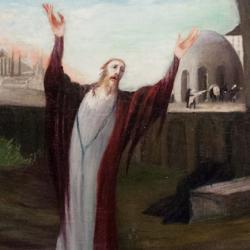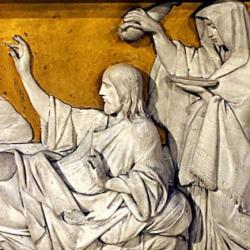1) Jesus’ infancy anticipates His passion, a point that Matthew makes by including multiple verbal and thematic connections between his opening and closing chapters. One example: Matthew is the only NT writer to quote Jeremiah by name, and he quotes him twice – in 2:18 and 27:9-10. The first describes the slaughter of the infants, the latter the field purchased with Judas’s blood-money.
Since Matthew is presenting Jesus as the true “son,” the true Israel (2:15), this parallel of beginning and end also applies to Israel’s history. Abraham’s history begins with a call from Ur; Israel’s national history begins with an exodus from Egypt. Israel’s history concludes (in the OT) with the call to return from Babylon (especially in the MT, where Cyrus’s decree closes the canon).
As the true Israel, Jesus’ history has the same inclusio. And that suggests that there is an “exilic” moment at the end of the gospel story, matching the exile-and-return of chapter 2. The ending exile-and-return would seem to be the cross and resurrection. Thus, Matthew’s structure, which reveals the structure of Israel’s history, gives us an atonement theology that highlights the cross as Jesus’ endurance of the curse of exile.
2) Matthew’s quotation from Jeremiah 31 (2:18) supports this. He quotes the one gloomy verse in a passage concerning return from exile and new covenant. Rachel weeps for her children that are gathered at Ramah and packed off to Babylon. But Matthew intends for the reader to bring the whole chapter to mind, and to realize that Rachel’s lamentation will give way to joy. This anticipates the pattern of the end of Matthew’s gospel, where the Messianic woes of the cross are the pathway to the joy of resurrection. In chapter 2, the woes are the woes of exile, and joy is the joy of return. The same is true at the end of the gospel.
3) Jeremiah 31 interestingly reverses the situation on which it’s based, the death of Rachel. In Genesis, Rachel dies in Bethlehem, with Ramah nearby; in Jeremiah (and Matthew), Rachel weeps for her children who are not. The death of the mother shifts to the death of her children. Why? How did Jeremiah find a type of exile in Rachel’s death? Perhaps this needs to be read through the lens of Isaiah 54, which describes return from exile as an end to barrenness, and this in turn would lead back to Rachel’s lamentation for her barrenness in Genesis.
4) The fulfillment formulae are of great hermeneutical interest, revealing something of Matthew’s way of reading prophecy. Matthew’s fulfillments turn on reversals and puns. Jesus fulfills Hosea 11:1, but Israel has become Egypt; “he will be called a Nazarene” depends on plays on Nazareth with Hebrew words, nazir and netzer at least. The logic of Matthew’s fulfillment formulae is very elusive, but I assume there is a logic there, which would become more apparent from deeper study of the passages he cites.
But Matthew’s fulfillments don’t fulfill the OT in a kind of photographically precise way, and this is the way that many have used the fulfilled prophecy apologetically – Hosea said God’s son would come out of Egypt; Jesus came out of Egypt; therefore, Jesus is Messiah. These fulfillment formulae are also directly relevant to what Jesus says about the “law and prophets” in chapter 5. If Jesus’ life fulfills prophecy in a strange, paradoxical, poetic way, shouldn’t we expect His ethics to fulfill the law and prophets in the same manner?











